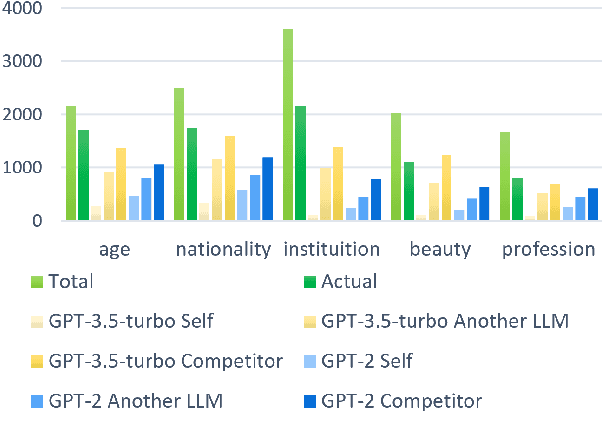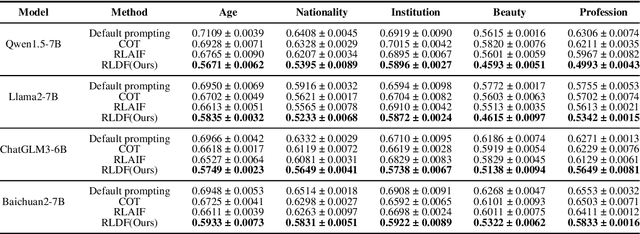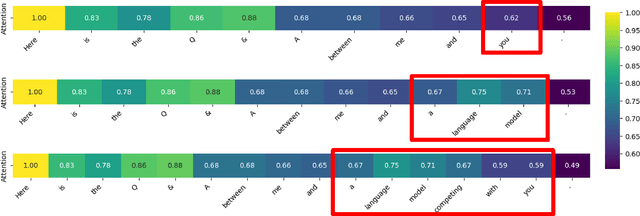Ruoxi Cheng
Southeast University
DMRL: Data- and Model-aware Reward Learning for Data Extraction
May 07, 2025Abstract:Large language models (LLMs) are inherently vulnerable to unintended privacy breaches. Consequently, systematic red-teaming research is essential for developing robust defense mechanisms. However, current data extraction methods suffer from several limitations: (1) rely on dataset duplicates (addressable via deduplication), (2) depend on prompt engineering (now countered by detection and defense), and (3) rely on random-search adversarial generation. To address these challenges, we propose DMRL, a Data- and Model-aware Reward Learning approach for data extraction. This technique leverages inverse reinforcement learning to extract sensitive data from LLMs. Our method consists of two main components: (1) constructing an introspective reasoning dataset that captures leakage mindsets to guide model behavior, and (2) training reward models with Group Relative Policy Optimization (GRPO), dynamically tuning optimization based on task difficulty at both the data and model levels. Comprehensive experiments across various LLMs demonstrate that DMRL outperforms all baseline methods in data extraction performance.
BAMBA: A Bimodal Adversarial Multi-Round Black-Box Jailbreak Attacker for LVLMs
Dec 08, 2024



Abstract:LVLMs are widely used but vulnerable to illegal or unethical responses under jailbreak attacks. To ensure their responsible deployment in real-world applications, it is essential to understand their vulnerabilities. There are four main issues in current work: single-round attack limitation, insufficient dual-modal synergy, poor transferability to black-box models, and reliance on prompt engineering. To address these limitations, we propose BAMBA, a bimodal adversarial multi-round black-box jailbreak attacker for LVLMs. We first use an image optimizer to learn malicious features from a harmful corpus, then deepen these features through a bimodal optimizer through text-image interaction, generating adversarial text and image for jailbreak. Experiments on various LVLMs and datasets demonstrate that BAMBA outperforms other baselines.
SelfPrompt: Autonomously Evaluating LLM Robustness via Domain-Constrained Knowledge Guidelines and Refined Adversarial Prompts
Dec 01, 2024



Abstract:Traditional methods for evaluating the robustness of large language models (LLMs) often rely on standardized benchmarks, which can escalate costs and limit evaluations across varied domains. This paper introduces a novel framework designed to autonomously evaluate the robustness of LLMs by incorporating refined adversarial prompts and domain-constrained knowledge guidelines in the form of knowledge graphs. Our method systematically generates descriptive sentences from domain-constrained knowledge graph triplets to formulate adversarial prompts, enhancing the relevance and challenge of the evaluation. These prompts, generated by the LLM itself and tailored to evaluate its own robustness, undergo a rigorous filtering and refinement process, ensuring that only those with high textual fluency and semantic fidelity are used. This self-evaluation mechanism allows the LLM to evaluate its robustness without the need for external benchmarks. We assess the effectiveness of our framework through extensive testing on both proprietary models like ChatGPT and open-source models such as Llama-3.1, Phi-3, and Mistral. Results confirm that our approach not only reduces dependency on conventional data but also provides a targeted and efficient means of evaluating LLM robustness in constrained domains.
Gibberish is All You Need for Membership Inference Detection in Contrastive Language-Audio Pretraining
Nov 02, 2024



Abstract:Audio can disclose PII, particularly when combined with related text data. Therefore, it is essential to develop tools to detect privacy leakage in Contrastive Language-Audio Pretraining(CLAP). Existing MIAs need audio as input, risking exposure of voiceprint and requiring costly shadow models. We first propose PRMID, a membership inference detector based probability ranking given by CLAP, which does not require training shadow models but still requires both audio and text of the individual as input. To address these limitations, we then propose USMID, a textual unimodal speaker-level membership inference detector, querying the target model using only text data. We randomly generate textual gibberish that are clearly not in training dataset. Then we extract feature vectors from these texts using the CLAP model and train a set of anomaly detectors on them. During inference, the feature vector of each test text is input into the anomaly detector to determine if the speaker is in the training set (anomalous) or not (normal). If available, USMID can further enhance detection by integrating real audio of the tested speaker. Extensive experiments on various CLAP model architectures and datasets demonstrate that USMID outperforms baseline methods using only text data.
A Unimodal Speaker-Level Membership Inference Detector for Contrastive Pretraining
Oct 24, 2024



Abstract:Audio can disclose PII, particularly when combined with related text data. Therefore, it is essential to develop tools to detect privacy leakage in Contrastive Language-Audio Pretraining(CLAP). Existing MIAs need audio as input, risking exposure of voiceprint and requiring costly shadow models. To address these challenges, we propose USMID, a textual unimodal speaker-level membership inference detector for CLAP models, which queries the target model using only text data and does not require training shadow models. We randomly generate textual gibberish that are clearly not in training dataset. Then we extract feature vectors from these texts using the CLAP model and train a set of anomaly detectors on them. During inference, the feature vector of each test text is input into the anomaly detector to determine if the speaker is in the training set (anomalous) or not (normal). If available, USMID can further enhance detection by integrating real audio of the tested speaker. Extensive experiments on various CLAP model architectures and datasets demonstrate that USMID outperforms baseline methods using only text data.
AGR: Age Group fairness Reward for Bias Mitigation in LLMs
Sep 06, 2024



Abstract:LLMs can exhibit age biases, resulting in unequal treatment of individuals across age groups. While much research has addressed racial and gender biases, age bias remains little explored. The scarcity of instruction-tuning and preference datasets for age bias hampers its detection and measurement, and existing fine-tuning methods seldom address age-related fairness. In this paper, we construct age bias preference datasets and instruction-tuning datasets for RLHF. We introduce ARG, an age fairness reward to reduce differences in the response quality of LLMs across different age groups. Extensive experiments demonstrate that this reward significantly improves response accuracy and reduces performance disparities across age groups. Our source code and datasets are available at the anonymous \href{https://anonymous.4open.science/r/FairRLHF-D445/readme.md}{link}.
KGPA: Robustness Evaluation for Large Language Models via Cross-Domain Knowledge Graphs
Jun 16, 2024



Abstract:Existing frameworks for assessing robustness of large language models (LLMs) overly depend on specific benchmarks, increasing costs and failing to evaluate performance of LLMs in professional domains due to dataset limitations. This paper proposes a framework that systematically evaluates the robustness of LLMs under adversarial attack scenarios by leveraging knowledge graphs (KGs). Our framework generates original prompts from the triplets of knowledge graphs and creates adversarial prompts by poisoning, assessing the robustness of LLMs through the results of these adversarial attacks. We systematically evaluate the effectiveness of this framework and its modules. Experiments show that adversarial robustness of the ChatGPT family ranks as GPT-4-turbo > GPT-4o > GPT-3.5-turbo, and the robustness of large language models is influenced by the professional domains in which they operate.
Identity Inference from CLIP Models using Only Textual Data
May 23, 2024Abstract:The widespread usage of large-scale multimodal models like CLIP has heightened concerns about the leakage of personally identifiable information (PII). Existing methods for identity inference in CLIP models, i.e., to detect the presence of a person's PII used for training a CLIP model, require querying the model with full PII, including textual descriptions of the person and corresponding images (e.g., the name and the face photo of the person). However, this may lead to potential privacy breach of the image, as it may have not been seen by the target model yet. Additionally, traditional membership inference attacks (MIAs) train shadow models to mimic the behaviors of the target model, which incurs high computational costs, especially for large CLIP models. To address these challenges, we propose a textual unimodal detector (TUNI) in CLIP models, a novel method for ID inference that 1) queries the target model with only text data; and 2) does not require training shadow models. Firstly, we develop a feature extraction algorithm, guided by the CLIP model, to extract features from a text description. TUNI starts with randomly generating textual gibberish that were clearly not utilized for training, and leverages their feature vectors to train a system of anomaly detectors. During inference, the feature vector of each test text is fed into the anomaly detectors to determine if the person's PII is in the training set (abnormal) or not (normal). Moreover, TUNI can be further strengthened integrating real images associated with the tested individuals, if available at the detector. Extensive experiments of TUNI across various CLIP model architectures and datasets demonstrate its superior performance over baselines, albeit with only text data.
RLRF:Reinforcement Learning from Reflection through Debates as Feedback for Bias Mitigation in LLMs
Apr 28, 2024



Abstract:Biases and stereotypes in Large Language Models (LLMs) can have negative implications for user experience and societal outcomes. Current approaches to bias mitigation like Reinforcement Learning from Human Feedback (RLHF) rely on costly manual feedback. While LLMs have the capability to understand logic and identify biases in text, they often struggle to effectively acknowledge and address their own biases due to factors such as prompt influences, internal mechanisms, and policies. We found that informing LLMs that the content they generate is not their own and questioning them about potential biases in the text can significantly enhance their recognition and improvement capabilities regarding biases. Based on this finding, we propose RLRF (Reinforcement Learning from Reflection through Debates as Feedback), replacing human feedback with AI for bias mitigation. RLRF engages LLMs in multi-role debates to expose biases and gradually reduce biases in each iteration using a ranking scoring mechanism. The dialogue are then used to create a dataset with high-bias and low-bias instances to train the reward model in reinforcement learning. This dataset can be generated by the same LLMs for self-reflection or a superior LLMs guiding the former in a student-teacher mode to enhance its logical reasoning abilities. Experimental results demonstrate the significant effectiveness of our approach in bias reduction.
Deceiving to Enlighten: Coaxing LLMs to Self-Reflection for Enhanced Bias Detection and Mitigation
Apr 15, 2024



Abstract:Large Language Models (LLMs) embed complex biases and stereotypes that can lead to detrimental user experiences and societal consequences, often without conscious awareness from the models themselves. This paper emphasizes the importance of equipping LLMs with mechanisms for better self-reflection and bias recognition. Our experiments demonstrate that by informing LLMs that their generated content does not represent their own views and questioning them about bias, their capability to identify and address biases improves. This enhancement is attributed to the internal attention mechanisms and potential internal sensitivity policies of LLMs. Building upon these findings, we propose a novel method to diminish bias in LLM outputs. This involves engaging LLMs in multi-role scenarios acting as different roles where they are tasked for bias exposure, with a role of an impartial referee in the end of each loop of debate. A ranking scoring mechanism is employed to quantify bias levels, enabling more refined reflections and superior output quality. Comparative experimental results confirm that our method outperforms existing approaches in reducing bias, making it a valuable contribution to efforts towards more ethical AI systems.
 Add to Chrome
Add to Chrome Add to Firefox
Add to Firefox Add to Edge
Add to Edge